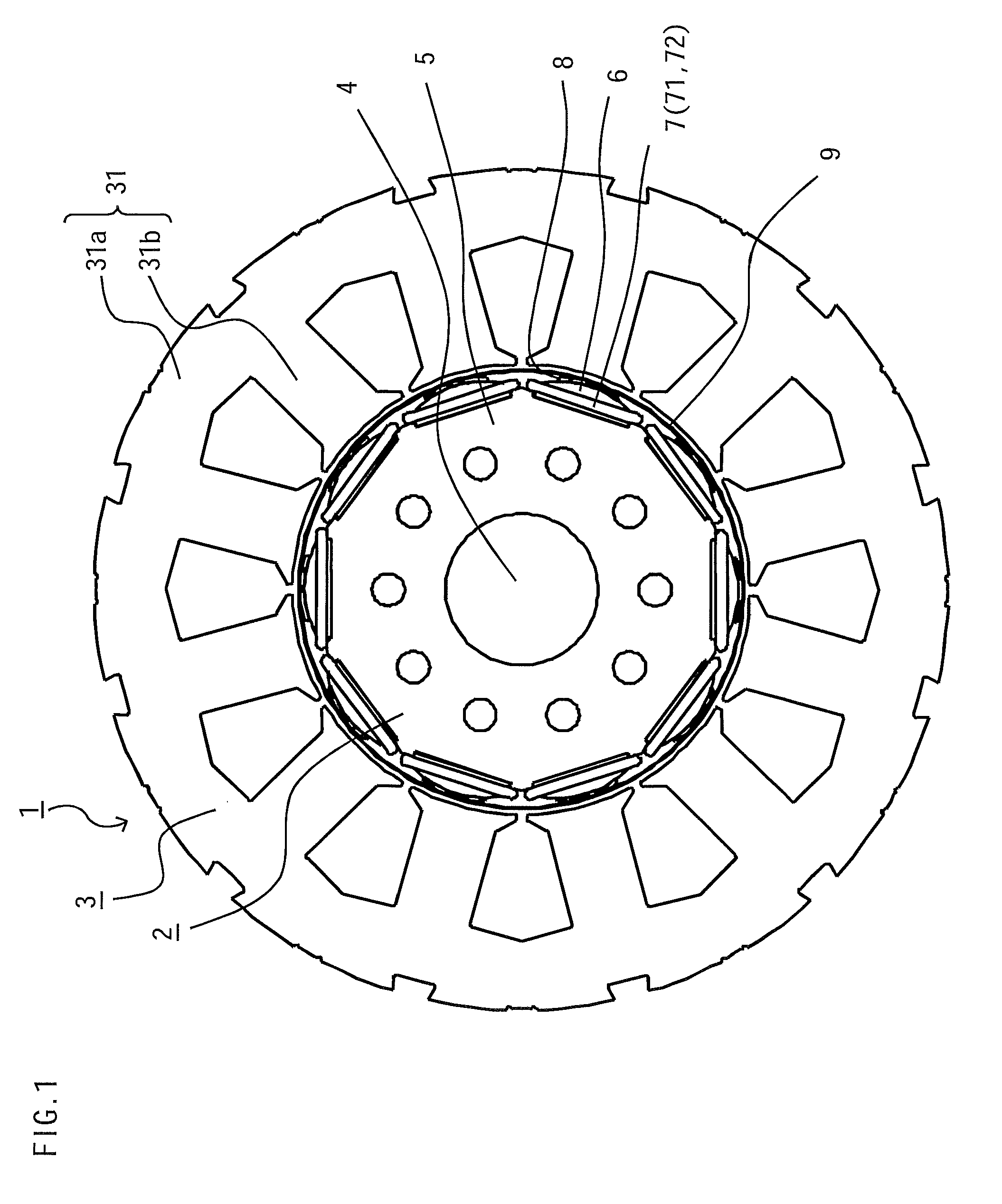Rotor of permanent magnet rotary machine and manufacturing method of rotor
a technology of rotary machine and rotor, which is applied in the direction of magnetic circuit rotating parts, instruments, magnetic circuit shape/form/construction, etc., can solve the problems of unsuitability of rotary machine employing ipm rotor, significant leakage of magnetic flux within the rotor, and distortion of surface flux distribution, so as to facilitate the detection of the angular position of the rotor, improve the saliency of the rotor, and avoid the effect of increasing noise or vibration
- Summary
- Abstract
- Description
- Claims
- Application Information
AI Technical Summary
Benefits of technology
Problems solved by technology
Method used
Image
Examples
first embodiment
[0027]FIG. 1 is a plan view showing the structure of a permanent magnet rotary machine (hereinafter referred to simply as the rotary machine) 1 according to a first embodiment of the invention, and FIG. 2 is a perspective view of a rotor 2 of the rotary machine 1.
[0028]As shown in FIGS. 1 and 2, the rotary machine 1 includes the rotor 2 and a stator 3 arranged to surround a circumferential surface of the rotor 2. The rotor 2 and the stator 3 are disposed with a specific air gap therebetween. Although not illustrated in detail, the stator 3 includes a stator core 31 having a yoke 31a and teeth 31b and stator coils 32 (not shown) wound around the individual teeth 31b.
[0029]The rotor 2 includes a rotary shaft 4, a rotor core 5 fixed around a circumferential surface of the rotary shaft 4, a plurality of permanent magnets 6 arranged on a circumferential surface of the rotor core 5 at specific intervals along a circumferential direction thereof, a plurality of conducting circuits 7 arran...
second embodiment
[0045]While the rotor 2 of the rotary machine 1 of the foregoing first embodiment is structured such that the conducting circuits 7 provided independently of one another are arranged to surround the individual permanent magnets 6, a rotary machine according to a second embodiment of the invention described hereunder has a conducting circuit 11 which is configured differently as compared to the first embodiment. It is to be noted that elements identical or similar to those of the first embodiment are designated by the same reference numerals in the following discussion and accompanying drawings and a description of such elements is not given below.
[0046]FIG. 4 is a perspective view showing the structure of a rotor 10 according to a second embodiment. To facilitate understanding of the structure of the rotor 10, the rotary shaft 4 and the binding member 9 are not shown in FIG. 4.
[0047]Referring to FIG. 4, the conducting circuit 11 of the rotor 10 is configured with a plurality of firs...
third embodiment
[0063]While the rotor 2 of the rotary machine 1 of the foregoing first embodiment is structured such that the magnetic material pieces 8 are arranged on the outer surfaces of the individual permanent magnets 6 independently of one another, a rotor 20 of a rotary machine according to a third embodiment described below has a magnetic material piece 21 configured differently from the first embodiment. It is to be noted that elements identical or similar to those of the first embodiment are designated by the same reference numerals in the following discussion and accompanying drawings and a description of such elements is not given below.
[0064]FIG. 8 is a plan view showing the structure of the rotor 20 according to the third embodiment of the invention. As shown in FIG. 8, the magnetic material piece 21 of the rotor 20 of this embodiment is a generally cylindrical body of magnetic material including magnetic pole portions 22 and intra-pole portions 23. The magnetic pole portions 22 are ...
PUM
| Property | Measurement | Unit |
|---|---|---|
| electrical angle | aaaaa | aaaaa |
| thickness | aaaaa | aaaaa |
| thickness | aaaaa | aaaaa |
Abstract
Description
Claims
Application Information
 Login to View More
Login to View More - R&D
- Intellectual Property
- Life Sciences
- Materials
- Tech Scout
- Unparalleled Data Quality
- Higher Quality Content
- 60% Fewer Hallucinations
Browse by: Latest US Patents, China's latest patents, Technical Efficacy Thesaurus, Application Domain, Technology Topic, Popular Technical Reports.
© 2025 PatSnap. All rights reserved.Legal|Privacy policy|Modern Slavery Act Transparency Statement|Sitemap|About US| Contact US: help@patsnap.com



